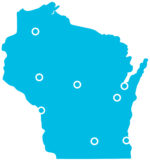 Supporting Families Together Association (SFTA) is a statewide association of child care resource agencies and family resources agencies throughout Wisconsin. SFTA helps these agencies by providing program management, organizational development, systems building, and professional development services. This project focused on a tool for the eight participating child care resource agencies. This tool also provides aggregated statewide data to SFTA.
Supporting Families Together Association (SFTA) is a statewide association of child care resource agencies and family resources agencies throughout Wisconsin. SFTA helps these agencies by providing program management, organizational development, systems building, and professional development services. This project focused on a tool for the eight participating child care resource agencies. This tool also provides aggregated statewide data to SFTA.
Each child care resource agency is independent, but the resource agencies have core functions in common including providing referrals for childcare in their areas. The individual child care resource agencies are tasked with helping to improve childcare in their area through training and technical assistance. They also help potential child care centers start their business through one-on-one assistance as they pursue their state child care license.
Challenge: Legacy System No Longer Meeting Association’s Needs
The childcare resource agencies all used a legacy tool called Naccrraware to track clients, childcare providers and referrals. While Naccrraware met some of their needs, there were a number of a significant pain points. Parents wanting to do an online search had to create a login and enter a significant amount of data before searching for providers in their area. There was limited ability to customize or add fields. When a funder required new information for reporting, the agencies had to create workarounds using existing fields and then manipulated the data to meet their needs. Furthermore, there was no link from pre-licensing support to the tracking of licensed providers, so there was no way to see the full lifecycle of a provider. Finally there was no way for a provider to update their information online; all updates were handled in a massive annual paper-based process.
Solution: Customizable Salesforce-instances For Each Agency, Built Around a Common Core
“This project was started with a long term vision to (1) improve the user experience for both families and child care providers and (2) advance our internal operations to be more efficient, effective and agile.”
– Erik Larson, Co-Director, Operations, Supporting Families Together Association
The goal for the project was to provide SFTA and each participating agency with a Salesforce system that allows them to manage referrals, providers (including provider listings and tracking providers licensing and pre-licensing status), trainings and reporting. Clients can either call their local agency for a referral or access childcare referrals online with no login necessary. SFTA also needed to track detailed statistics on referrals and providers so they could report to various funders from this database.
Aggregates Statewide Data and Supports Local Agency Customizations
Each agency has their own needs alongside the core functions needed by SFTA. Because of this, we created one core system and then deployed it to individual Salesforce instances for each agency. This allows them to easily make their own changes and modifications to meet their local needs going forward.
A key requirement for SFTA, as the statewide organization, was to see aggregated data across all eight local agencies. To meet this need, Workato was used to connect the eight agency Salesforce systems to the statewide system. Workato “recipes” were built for each primary object that needs to sync, such as Accounts and Referrals. The recipes trigger when records are created or updated, and the appropriate fields and records are synced between the agencies and SFTA.

This synchronization has enabled SFTA to have a holistic view of critical data from across the state, while each regional agency sees only its own data in its own instance:

Automate Provider Updates
Once a year, the agencies ask their providers to provide updated information. In the past, this was an eight page paper form that was sent to each provider to fill out and return. As you can imagine, there was a lot of back and forth to follow-up to get information that was completed or to get forms that were not sent back.
Here is a snapshot of 4 pages of the paper form:
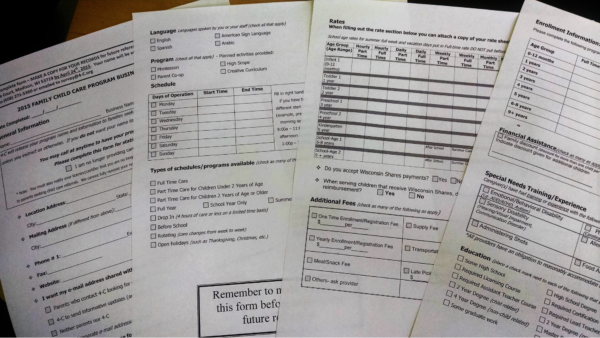
To streamline this process, FormAssembly forms are used as the cost-effective solution to this problem. Each provider is emailed a link to a FormAssembly form that is pre-filled with their own data. The provider only needs to update information that has changed. This saves the agencies a significant amount of time and cost in printing, mailing and following-up. When the form is submitted, the data is automatically updated in Salesforce. The agency can quickly see a report of which providers have not yet returned their form and then send them a reminder email.
Pre-filled forms allow the providers to focus on what has changed rather than entering all the data. In the example below, licensing requirements dictate that providers are not allowed to change their location address, but they can provide an optional mailing address. The optional mailing address fields will only show if they indicate that they do have an alternate address.
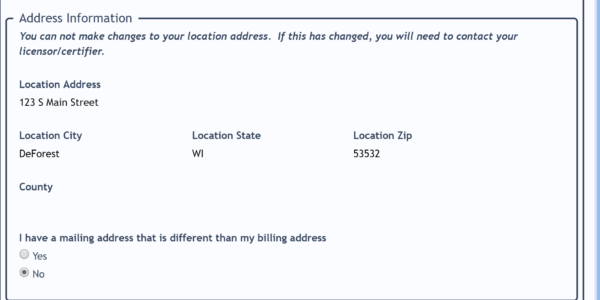
Below is the hours of operation information collected. The provider can verify that the hours on record are correct and change those that are incorrect.

To efficiently roll out a FormAssembly form to eight different organizations, a base form was cloned to each agency’s FormAssembly account. This allows them to customize the forms to add information required by their unique grants.
Provide Parents Rich Search Capabilities, Including Interactive Maps
A core requirement was the ability to have parents search online for providers that meet key criteria in their area and for the referral specialist to complete more detailed searches for parents who call in.
To meet this requirement, we used Force.com public sites to allow parents the ability to search the database from an agency website. The search provides results to the parent but also stores their results in custom objects in Salesforce. This allows agency referral specialists to report on search results and follow-up with the parent. Using Google Maps API, the parent is provided with an interactive map of their search results. Using the App Cloud’s native geolocation functionality, the site identifies providers in the database that are within a specified search radius of a particular address. Parents can enter multiple addresses representing homes, places of work, or other community areas near which they might want childcare.
Parents can also enter multiple children and each child’s age and any special needs. The site distinguishes “Best Bets,” meaning providers who meet the particular needs of all of their children, and also returns other providers who meet the needs of at least one of their children.
Since each agency had their own local needs, the search feature needed to be customizable. Administrators in each agency can declaratively add additional demographic fields on the search form and can declaratively change the results page layout.
To search for childcare providers, parents fill out some basic information(address, distance, child age, and time periods of care needed, type of care):
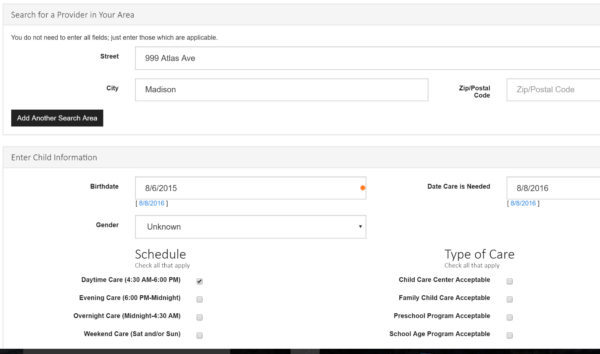
The search results return a map of providers in their area along with details on each provider:

Each childcare provider has public facing details about their offerings:
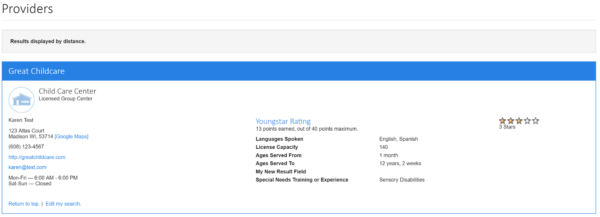
Leverage a Cross-Agency Committee to Effectively Manage a Multi-Agency Rollout
Rolling out a system to multiple organizations simultaneously is a tricky process. It was key to the success of this project that the SFTA team and participating agencies took ownership of their system quickly and immediately. It was also key that they already had a cross-agency data committee in place that met regularly and agreed on core functionality and data standards.
During the project, we built one system that was tested and accepted by the client team, the SFTA project team and representatives from two agencies. When all was ready to go, we deployed the code into the eight agency Salesforce instances and completed a test migration of the data from Naccraware into the eight different Salesforce instances.
Leading up this point, the SFTA project team worked with the administrators at each agency to start to train them and get them up to speed. After the test migration, the SFTA team had weekly meetings to do additional training and exercises. We also held an on-site where all the agency administrators came together along with the referral specialists to do hands-on training.
When the testing and training was complete, the production data was migrated into the system and SFTA along with the eight member agencies were live with the new system!
Impact So Far
Moving from a legacy product to a platform such as Salesforce is a big change, especially when spread across eight different agencies. One early win has been giving the agencies the ability to send their providers a pre-filled form for updates. For one agency, they tripled the return rate for the Provider Profile update – from 19% to 60%. This not only has saved them the expense of printing and mailing but significant time in entering data and now they have more accurate data on their provider services, hours, and rates to provide to the parents and caregivers seeking childcare.
As a product, Naccraware had minimal customization options. Salesforce has enabled each agency to customize their instance to gather data needed to their specific funders. Salesforce’s reporting capabilities have also provided big benefits. They are able to easily create reports and schedule them for different users. The reports along with Dashboards have given the agencies visibility into what is happening at any given time in their organization.